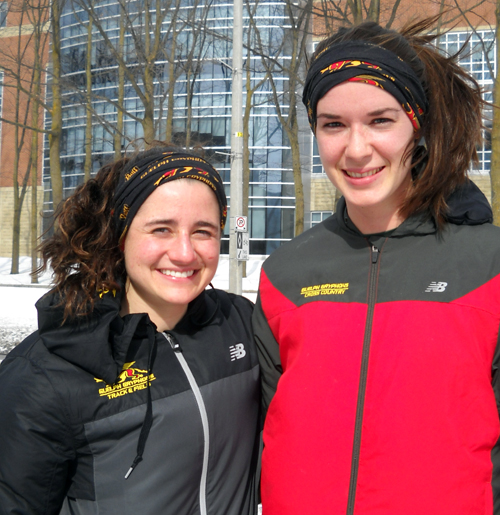
“Do 10 laps and call me in the morning.” If an international campus project being spearheaded by human health researchers at U of G pans out, more doctors will be prescribing not just drugs to their patients but push-ups, leg lifts and other forms of exercise.
Encouraging health professionals to promote physical activity in disease prevention and treatment is the main goal of a global initiative called Exercise Is Medicine (EIM) that arrived here on campus last fall.
Since then, students in the Department of Human Health and Nutritional Sciences (HHNS) have been sharing the “exercise is medicine” mantra with health care practitioners and groups both on and off campus.
They’re also planning promotional events, including a campus cycling fitness challenge and a wider community EIM symposium. They’ve even got copies of exercise prescription pads developed by EIM Canada for doctors to use, just like writing drug prescriptions for patients.
In 2013, Guelph became the second Canadian university to take part in the project, following Queen’s University. McMaster University has since joined, and other schools plan to take part.
Besides improving health, Exercise is Medicine Canada @ Guelph (EIMC@Guelph) is intended to give HHNS students and graduates practical opportunities to share what they’re learning here with a wider audience.
Alison Ludzki, a master’s student in exercise physiology, is helping to lead the Guelph project. She says it’s meant “to connect researchers and health-care providers and give them tools to safely prescribe exercise for health.”
“That’s extremely important,” says project co-leader Lydia Frost, B.Sc. ’12, who is working on her master’s in biomechanics. “Just getting the bridge between the research and clinical sides is, I think, the really big part of Exercise Is Medicine.”
Along with about 30 student members – mostly in human kinetics and biomedical sciences — they plan several campus and community events this spring, including a promo to measure cardiorespiratory fitness and a cycling fitness challenge during this year’s Science Olympics and Ms Infinity event for high school students.
They are discussing exercise programs with practitioners who work with older adults in Guelph. They aim to visit local high schools to discuss exercise science and share career options such as kinesiology, exercise physiology and cardiac rehabilitation. And they’re planning a pilot lunch-hour program at an elementary school to introduce creative ways to stay physically active.
“The key is finding something you want to do every day rather than be forced,” says Frost. As with Ludzki, she ran with varsity teams and now belongs to the Speed River Club in Guelph.
EIMC@Guelph will hold a symposium on campus for the Guelph community in late March, including talks by medical researchers and practitioners.
Organizers also expect to discuss the project with Student Health Services (SHS) on campus. “We have been very interested in the Exercise is Medicine program and are looking for a time to introduce it to our physicians,” says SHS director Lynda Davenport. “This program appears to have great potential in the management of chronic illness and injury.”
Exercise Is Medicine was begun in the United States in 2007 by the American College of Sports Medicine (ACSM). The project was adopted two years ago by the Canadian Society for Exercise Physiology (CSEP)
Working with university campuses allows organizers to tap into enthusiasm and to tie together research and physician care, says Susan Yungblut, director of Exercise Is Medicine Canada at CSEP’s Ottawa office.
“We’re finding a wealth of passion and excitement among students in kinesiology, human kinetics, exercise physiology programs or health-care programs including medicine or physiotherapy,” she says. “Students are excited about integrating physical activity and exercise into the health-care system to improve patient care.”
Doctors and other health-care professionals typically receive little training in this area in medical school, says Yungblut.
Prof. Lawrence Spriet, HHNS chair, served on the board of directors of the ACSM in the United States and has been involved with EIM since its inception. Many exercise physiologists in HHNS also belong to the organization.
For Spriet, the project is all about using physical activity as preventive medicine. Doctors are key, he says: “They would prescribe physical activity just like they would prescribe drugs.”
He says Guelph brings numerous strengths to this initiative, including a range of experts in exercise physiology, nutrition and physical activity within HHNS as well as researchers in related departments from Family Relations and Applied Nutrition to Food Science. Many U of G graduates go on to become health-care workers from doctors and nurses to physiotherapists.
“Guelph is one of the leaders,” says Yungblut. “There is no medical school, and yet that’s not a barrier. So the students have done what I envisioned, which is to take what they have, what their interests are, and create an initiative that suits their expertise and passions.”